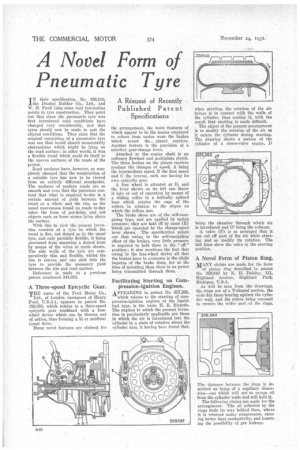A Novel Form of Pneumatic Tyre
Page 64

If you've noticed an error in this article please click here to report it so we can fix it.
A Resume of Recently Published Patent Specifications
IN their specification, No. 359,110, the Dunlop Rubber Co., Ltd., and W. H. Paull raise some very interesting points in tyre construction. They point out that since the pneumatic tyre was first introduced road conditions have changed very considerably, and that tyres should now be made to suit the altered conditions. They state that the original conception of a pneumatic tyre was one that would absorb momentarily obstructions which might be lying on the road surface; in other words, it was a flexible tread which could fit itself to the uneven surfaces of the roads of the period.
Road surfaces have, however, so completely changed that the construction of a suitable tyre has now to be viewed from an entirely different standpoint. The surfaces of modern roads are so smooth and even that the patentees contend that what is required to-day is a certain amount of yield between the tread as a whole and the rim, as the usual unevenness found on roads to-day takes the form of pot-holes, and not objects such as loose stones lying above the surface.
With this in view the present invention consists of a tyre in which the tread is flat, not domed as in the usual tyre, and only partially flexible, it being prevented from assuming a domed form by means of the wires or cords shown. The side walls of the tyre are comparatively thin and flexible, whilst the rim is convex and can sink into the tyre to provide the necessary yield between the rim and road surface.
Reference is made to a previous patent numbered 344,383.
A Three-speed Epicyclic Gear.
THE name of the Ford Motor Co„ Ltd., of London (assignees of Henry Ford, U.S.A.), appears in patent No. 359,355, which relates to a three-speed epicyclic gear combined with a freewheel device which can be thrown out of action, thus forming a hi or unidirectional drive.'
Many novel features are claimed for the arrangement, the main features of which appear to be the means employed to relieve from undue wear the brakes which arrest the, planet carriers. Another feature is the provision of a selective gear-change lever.
Attached to the. engine shaft is an ordinary flywheel and multiplate clutch. The three brakes on the planet carriers produce the changes of speed, A being the intermediate speed, B the first speed and C the reverse, each one having its own epicyclic gear.
A free wheel is situated at D, and the lever shown on its left can throw it into or out of operation by means of a sliding collar in a helically splined boss which rotates the cage of the rollers in relation to the slopes on which the rollers jam.
The brake shoes are of the self-energizing type, and are applied by spring pressure; they are held off by cams (E) 'which are operated by the change-speed lever shown. The specification points out that owing to the self-energizing effect of the brakes, very little pressure is required to hold them in the " off " position; it also mentions the fact that owing to the free-wheel device all that the brakes have to overcome is the slight impetus of the brake discs, for at the time of arresting them there is no power being transmitted through them.
Facilitating Starting on Compression-ignition Engines.
APPEARING in patent No. 357,262, which relates to the starting of compression-ignition engines of the liquidfuel type, is the name H. R. Ricardo. The engines to which the present invention is particularly applicable are those in which the air is introduced into the cylinder in a state of rotation about the cylinder axis, it having been found that,




































































































